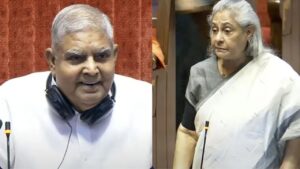ButSpeak.com
News which Matters.

Tensions between opposition parties and Rajya Sabha Chairman Jagdeep Dhankhar escalate, with plans to introduce a resolution for his removal, citing partisan actions and breaches of House procedures.
The relationship between opposition parties and Rajya Sabha Chairman Jagdeep Dhankhar has reached a critical point, with sources indicating that the opposition is considering an unprecedented move to seek his removal. The tensions have escalated throughout the monsoon session, culminating in discussions among opposition leaders about the feasibility of bringing a formal resolution for the Vice-President’s removal.
This proposed action stems from what opposition parties describe as a series of partisan decisions made by Dhankhar, who, as Chairman of the Rajya Sabha, is expected to maintain impartiality in the upper house of Parliament. A senior opposition member, speaking on the condition of anonymity, expressed concern that Dhankhar has “overruled norms and procedures to the advantage of the treasury benches,” thereby compromising the dignity of his constitutional role.
According to sources, a total of 87 members have already signed the proposal to initiate the removal process. These members have reportedly been compiling documentation to substantiate their claims of Dhankhar’s partiality. Among the complaints are allegations that the microphone of the leader of the opposition has been turned off multiple times, preventing them from speaking during crucial debates.
The procedure for removing the Chairman of the Rajya Sabha is complex and involves multiple steps as outlined in the Constitution of India. The process begins with a resolution moved in the Rajya Sabha, requiring the support of at least half of the members present plus one. If passed, the resolution then moves to the Lok Sabha, where a simple majority is needed for final approval.
While the opposition is aware that the resolution is unlikely to pass, given the current political composition of Parliament, the move is seen as a symbolic gesture to draw attention to their grievances. A senior Rajya Sabha member explained that even if the resolution is defeated, it would serve to “prove the point that the chair has deviated from his role as a neutral umpire.”
The situation has already prompted discussions at the highest levels, with sources indicating that BJP leaders, including J P Nadda, have been informally notified about the potential motion. Meanwhile, Congress’s Rajya Sabha MP Ajay Maken has stated that “all options are open,” suggesting that the opposition is prepared to explore every legal and procedural avenue available to them.
As the opposition prepares to finalize its strategy, it remains to be seen how this conflict will unfold in the coming days. What is clear, however, is that the growing antagonism between the opposition and the Rajya Sabha Chairman could lead to further confrontations, both within and outside the halls of Parliament.